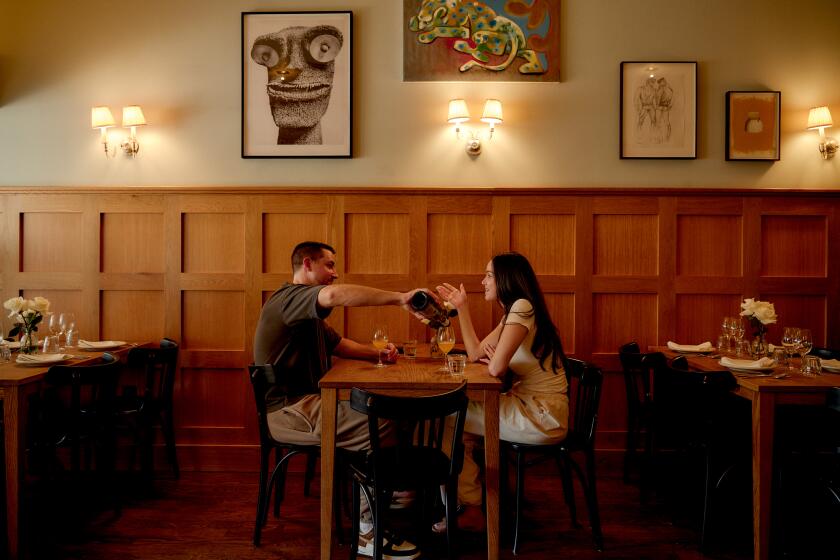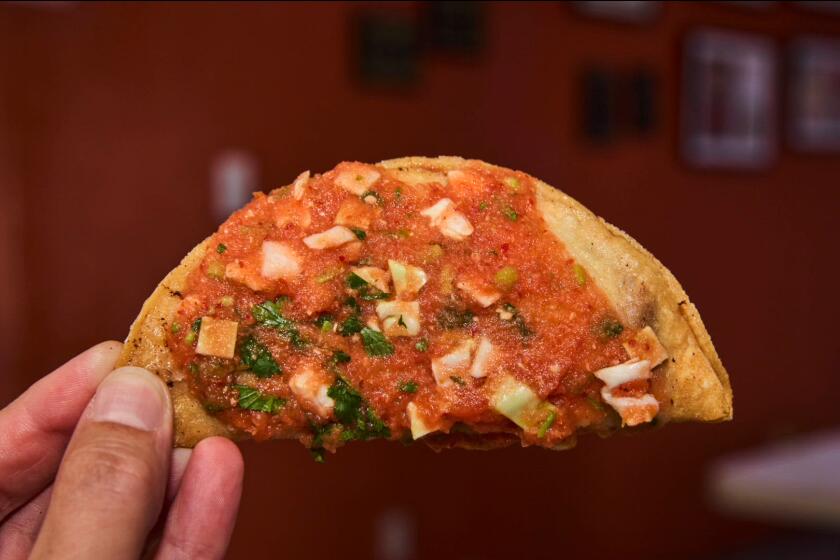A Napoleon Is Born
I remember the moment I fell in love with food. I was 5, and after one interminable morning of clothes shopping, my mother took me to lunch at the Bird Cage, the restaurant at Lord & Taylor. It changed the course of my life.
The room was dazzling. I remember white trellises with artificial vine tendrils and murals of foliage and sky. We sat at pink wrought-iron garden furniture and ate sandwiches on white bread without crusts. The restaurant played recorded birdcalls instead of music, and strategically scattered throughout the room were little birds with molded tissue paper bodies and real feathers for wings and tails.
I remember entering into the spirit of the occasion with delight and a little awe. My best “little lady” manners surfaced and I was a model child. The pasty tuna salad sandwiches on soggy white bread were what I wanted for lunch for the rest of my life. If they seemed tasteless, I assumed that it was because I was a child and would learn to appreciate them, as I had been assured would happen with coffee and green olives.
How could I have known what to expect when the dessert cart was rolled up? My mother nodded permission to choose, and the most amazing thing was that if you picked the very fanciest from the tray of exotic-looking things that you were sure had probably been made by magic, you got to pick again, and both would be put on your plate! In spite of my mother’s warning that I would be disappointed, I chose the pink diamond (she was right). She tried to get me to opt for an eclair, but they were not as beautiful.
But when she encouraged the choice of a Napoleon, I went along. Of course, it was that first Napoleon that did it. Put an exhausted 5-year-old in the middle of an artificial aviary and let her sit and eat the prettiest combination of rich and sweet known, and see if you don’t warp her forever.
I know now it probably was not the best Napoleon ever made. Even in my memory the filling was whipped and white, the leaves of pastry pale and papery. But at the time it was marvelous. I examined and dissected. I tried the parts in combination and alone. The dry crisp flakes, the smooth creamy filling and the sharply sweet icing were a revelatory experience. I needed to know how they did this thing.
More than 40 years later--almost half of them spent in pastry kitchens--I have a much clearer vision of what makes the perfect Napoleon. It is made an hour or less before I eat it, and it has not been refrigerated. The icing is crisp and thin, with a reflective shine. The filling is dense and smooth, yellow from yolks and distinctly vanilla-flavored. It has a touch of salt, but only if you pay close attention. The pastry layers have the nuttiness of baked flour and browned butter, without a trace of greasiness. These layers are 3/8 of an inch thick and an even, crisp, golden-brown throughout.
I regarded Napoleons as a tribute to my entire culinary history when I made them in my pastry shop in rural Chatham, in the foothills of the Berkshires near the New York-Massachussets border. The high school students who made up most of my work force were unsophisticated, and I delighted in turning them on to new taste sensations. The best was when they had their first Napoleons.
By that time my addiction to Napoleons had grown to such compulsive proportions that if I did not have someone to eat the scraps, I had to not only to throw them in the garbage but also immediately throw something vile on top of them to keep me from reaching in the trash for snacks. Such drastic measures were not necessary when there were 16-year-old helpers around. I admit to a guilty pleasure in this, but they were of consenting age. Perhaps we are doomed to perpetuate these cycles.
Making great Napoleons is not really hard, but there are no shortcuts. Most important is making your own puff pastry. Buying ready-made frozen puff pastry will get you the texture, but it is pretty flavorless.
The secret of perfect puff pastry? Equal weights of flour, butter and cream--and absolutely nothing else. Most bakers use water as the liquid in the dough, or detrempe, but I find the cream really puts the buttery flavor of it over the top.
There are a few other things I know about puff pastry:
* Beat some flour into the butter filling. In Europe, bakers use straight butter for beurrage, but our government permits 20% water in butter, so we need to add something to absorb excess liquid.
* When rolling the dough, you have to maintain the same consistency in the thinner and thinner layers of butter and dough. It cannot get warm or the butter will be absorbed into the dough. You must be vigilant about this. Twenty minutes in the refrigerator between “turns” is usually right, but you have to judge. If the butter layer gets too hard, let the dough warm up on the counter a few minutes. If it seems a bit soft, let it chill longer.
* You can’t really tell if the dough has been rolled evenly just by looking. Gently run your palm over the surface. You will feel the dough is higher where it needs a little more rolling. Remember to brush the excess flour off the dough before folding it. You will repeat the rolling process enough times that just that little bit of extra flour will wind up changing the proportions of ingredients.
* Finally, try not to stretch the dough while you are rolling it. When bakers mechanize this process, they feed it between two rollers, like a laundry wringer or mangle. They keep making the space between the rollers smaller, but they never pull on the dough. When you pull on it, it only springs back, getting more rubbery. You are trying to make it thin, not long.
Another trick of mine is the way I make my pastry cream. Most people temper the yolks with the hot milk, but if you dissolve the starch in the milk first and then stir this into the yolks, you can dump it all at once into the milk at a full boil. Then, of course, you must stir as if your life depends upon it to keep the mixture from scorching on the bottom.
Get it out of the pan fast, because it can burn just from the heat left in the pan. Should it scorch, just throw it out. Start over. No amount of straining will get rid of that nasty flavor.
Also, be sure to let the cream cool before you assemble the pastry. Otherwise, your lovely crisp sheets will get soggy immediately.
And be sure to share the scraps.
AMY’S PERFECT NAPOLEONS
To my way of thinking, this is the ultimate in pastry. The contrast of textures, crisp flakiness and superb smoothness, and the full range of rich dairy products result in a product of uncompromised integrity with enough complexity to hold the attention. If a hint of bitterness is detectable in the colors of the icing, it adds a bass note. The elaborate pattern has an understated, but detailed, elegance that corresponds to the whole and enhances the visual experience of it. How much nearer do we need to approach perfection?
If you work incrementally towards a dinner party on Saturday night, you could have the dough ready Tuesday, roll the sheets Friday, bake them on Saturday morning and assemble the pastries Saturday afternoon. But I would not stretch the time frame any longer than that.
Puff Pastry
Vanilla Pastry Cream
1 ounce bittersweet chocolate
Royal Icing
With very sharp knife, trim irregularities along edges of puff pastry sheets. Cut biggest sheet in half and match small sheet to halves. Gently turn sheets over and choose nicest piece for top of Napoleon and worst for middle.
Set piece for bottom smoother-side down on serving plate and spread pastry cream over top. Spread to edges and make cream level. Cream should be slightly thicker than pastry sheet. Now place middle pastry layer on top, smoother-side up, and gently press down, using a baking sheet for even pressure. Be careful not to snap sheet. Spread with another layer of pastry cream. Add last piece of puff pastry, smoother-side up, and with baking sheet, press in place.
Brush any crumbs off top Napoleon sheet. Warm 1 to 2 pounds of fondant and pour thick stripe down middle of pastry. Use spatula to quickly spread fondant to edges in thin, even coat. It is better to have some fondant run off edges of Napoleon than to not cover all of top. You must be careful not to break top layer of pastry with spatula.
In small bowl over simmering water, melt chocolate. Pur chocolate into paper cone; set aside in a warm place.
Pour Royal Icing down length of top of pastry and spread evenly with long-bladed metal spatula (try to spread in 1 stroke--going back will spread crumbs). Allow excess to drip over sides.
Pipe chocolate across rectangle in thin parallel lines about 1 inch apart. Use dull side of paring knife blade to drag lines across icing stripes. If you go back and forth at right angles to stripes, you will get classic chevron pattern.
When icing has hardened (touching with dry finger leaves print), cut into individual Napoleons, using serrated bread knife and pitcher of cold water deep enough to submerge whole blade.
Trim all outside edges clean, crisp and neat. When cutting iced surface, apply very little pressure and use sawing motion. Go swiftly through cream and saw again when you reach next crisp layer. Since bottom layer is supported by table, you do not have to be as careful. Make sure you cut through layer completely, though.
After each cut, blade must be washed and wiped clean. Otherwise, anything that remains on blade will wind up on top of pastry. When sides are done, cut sheet in half, long way. To keep sheets from shifting, place clean, dry, free hand, fingertips down, against side of sheet furthest from you. When you cut, slide blade between your middle and ring fingers. When sheet is cut in half, turn pastry so first cut runs from left to right.
Second cut should be made at width of 1 1/2 to 2 inches (I use width of my first two fingers placed together). Measure width and brace piece you are cutting off with opposite hand. Never forget to wipe blade between cuts. When you have finished cutting pastries, separate them using knife tip.
Carefully slide spatula beneath each pastry to transfer to service tray. Avoid touching icing. Place tray in cool, dry location until ready to serve. If you want to cover pastries, stand paper cups in corners of tray first, so plastic wrap does not adhere to icing. Carefully remove plastic wrap just before presentation. After you clean up, treat yourself to some trimmings.
Makes 12 Napoleons.
Each Napoleon contains about:
556 calories; 276 mg sodium; 280 mg cholesterol; 37 grams fat; 51 grams carbohydrates; 7 grams protein; 0.10 gram fiber.
PUFF PASTRY
By the end of the fourth repetition, you will have created 512 layers of dough. Give the finished dough an overnight rest before you roll it out to use it.
2 cups sifted flour (1/2 pound), plus 2 tablespoons (1/2 ounce)
1 cup heavy cream
Dash salt
1/2 pound butter
Make detrempe. In heavy duty mixer fitted with dough paddle, mix 2 cups flour, cream and salt, starting slowly, so as to avoid snowstorms. Dough will have to mix for more than 10 minutes. Eventually dough will collect on paddle. Bowl will look clean, but dough will look wet and stringy. Strings are gluten strands, protein chains that form when glutenin and gliaden in wheat flour link up and develop, giving dough strength.
Turn dough out on floured baking sheet. Cover with butter wrappers, plastic wrap or clean garbage bag to prevent drying and crusting. Refrigerate at least 20 minutes.
Make beurrage. Mix butter and remaining 2 tablespoons flour at low speed until there are no lumps, but do not cream mixture. Be careful not to allow color of mixture to lighten and do not increase mixture’s volume. Turn mixture out onto pan or sheet of wax paper and shape into square about 1 inch thick. Refrigerate.
When beurrage and detrempe have same consistency, (poke each with your finger to test), remove from refrigerator. Flour rolling table, which must be at least 4 times as long as baking sheet is wide. Flip square of detrempe dough onto table and roll out four thinner ears at right angles, leaving thicker cushion in middle. Place beurrage on cushion and fold ears over, like an envelope. Press to seal all edges of envelope. Flip over.
Starting at middle of dough, roll out to edges, but not over them. When you have done this once in all 4 directions, work in 1 direction only until dough is 4 times as long as baking sheet is wide. Occasionally check beneath dough to make sure table is floured enough and dough is not sticking to table.
When dough is long enough, roll out as wide as baking sheet is long. While you roll, keep in mind that you are making layers thinner. Pressure should be downwards, rather than across, which would make dough more elastic, resulting in tough final product.
If all has gone well, you now should have sheet of butter sandwiched between 2 sheets of dough. Sheet should be about 2 feet long, 8 inches wide and just under 1/2-inch thick. Fold two short sides to meet in middle. Dust off excess flour and fold one doubled side over other. Again dust off excess flour and transfer dough to cookie sheet. Re-cover dough and refrigerate at least another 20 minutes.
Sheet must be chilled to keep dough and butter separate. Chilling also maintains consistency so dough is pliable and rolls out evenly. If refrigerated too long, butter will become rigid and can form lumps that break through dough and melt, leaving holes in finished product. If dough has been over-chilled, warm to room temperature before continuing.
Flour rolling table again and turn dough out of pan. Align dough with table so you will be rolling long direction of dough along length of table. Roll dough out to same size and shape as before. Dough should be slightly easier to form into nice neat rectangle, this time. Fold as before, cover and refrigerate.
Repeat rolling and folding process twice more.
Form Napoleon sheets. Cut off 1/3 of puff pastry and set aside. Roll larger piece first, slightly larger than cookie sheet. Transfer pastry to cookie sheet by rolling onto pin and unrolling on pan, to avoid stretching or tearing dough. Refrigerate at least 20 minutes with excess dough hanging over edges of cookie sheet.
While dough is chilling, roll remaining piece to 1/2 size of first and refrigerate.
When ready to bake, trim excess dough from first sheet to match sides of baking sheet. Then prick sheet all over with fork. There should be at least 1 pinhole in every 2 square inches to prevent formation of air pockets and blistering. Repeat with smaller sheet.
Bake at 350 degrees until pastry is lovely golden color and smells of butter, about 30 to 40 minutes. When pressed lightly in middle, pastry will crumble rather than yield. Cool pastry on cookie sheet in dry place. If slightly overbaked, flip onto cool surface immediately to prevent scorching.
VANILLA PASTRY CREAM
1 quart half and half
1 cup sugar
1/4 teaspoon salt
1/4 cup cornstarch
8 egg yolks
2 tablespoons vanilla extract
Heat 3 1/2 cups half and half with sugar and salt over medium heat.
Whisk cornstarch into remaining half and half. Let mixture settle and check bottom of bowl with fingers to check for lumps of undissolved cornstarch. Re-whisk if necessary. Any lumps at this point will be lumps forever.
Whisk egg yolks until smooth, then gradually whisk in cornstarch mixture, making sure all is well combined.
Increase heat under saucepan to medium-high and cook until half and half starts to bubble at edges. As half and half boils, it will rise in pot. As half and half comes up, add eggs and cornstarch all at once and stir vigorously. This will drop temperature immediately, so mixture will not boil over.
Continue cooking, stirring constantly, until pastry cream thickens. When pastry cream comes to boil, remove from heat and immediately pour into mixing bowl. Use rubber spatula to remove all of pastry cream.
Immediately cover tightly to keep skin from forming, and as soon as possible, chill to room temperature and refrigerate. Once pastry cream is chilled, whisk in vanilla extract. Extract is alcohol-based and too much will evaporate if added when pastry cream is still hot.
ROYAL ICING
1 cup plus 3 tablespoons powdered sugar
1 egg white
1/2 teaspoon lemon juice
Sift powdered sugar through strainer into bowl. Whisk in egg white and lemon juice until smooth. When whisk is lifted, mixture should fall off in slow stream.
More to Read
Eat your way across L.A.
Get our weekly Tasting Notes newsletter for reviews, news and more.
You may occasionally receive promotional content from the Los Angeles Times.










